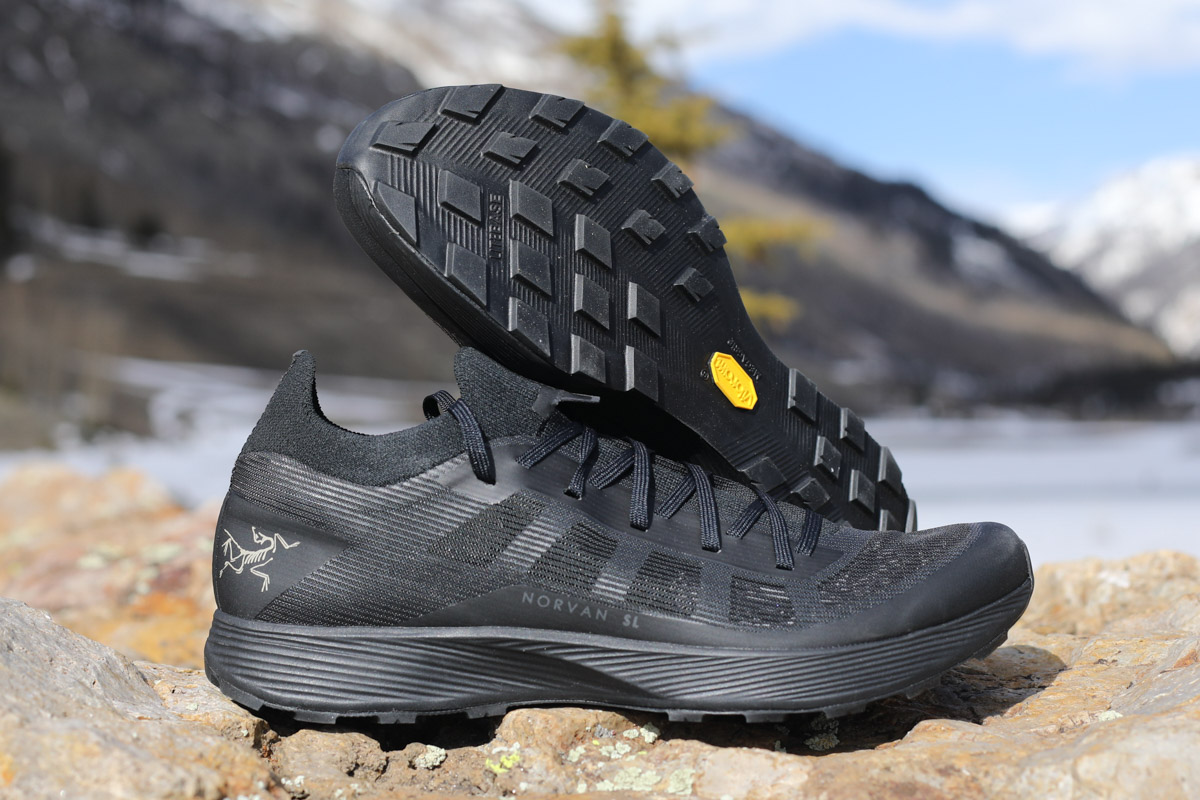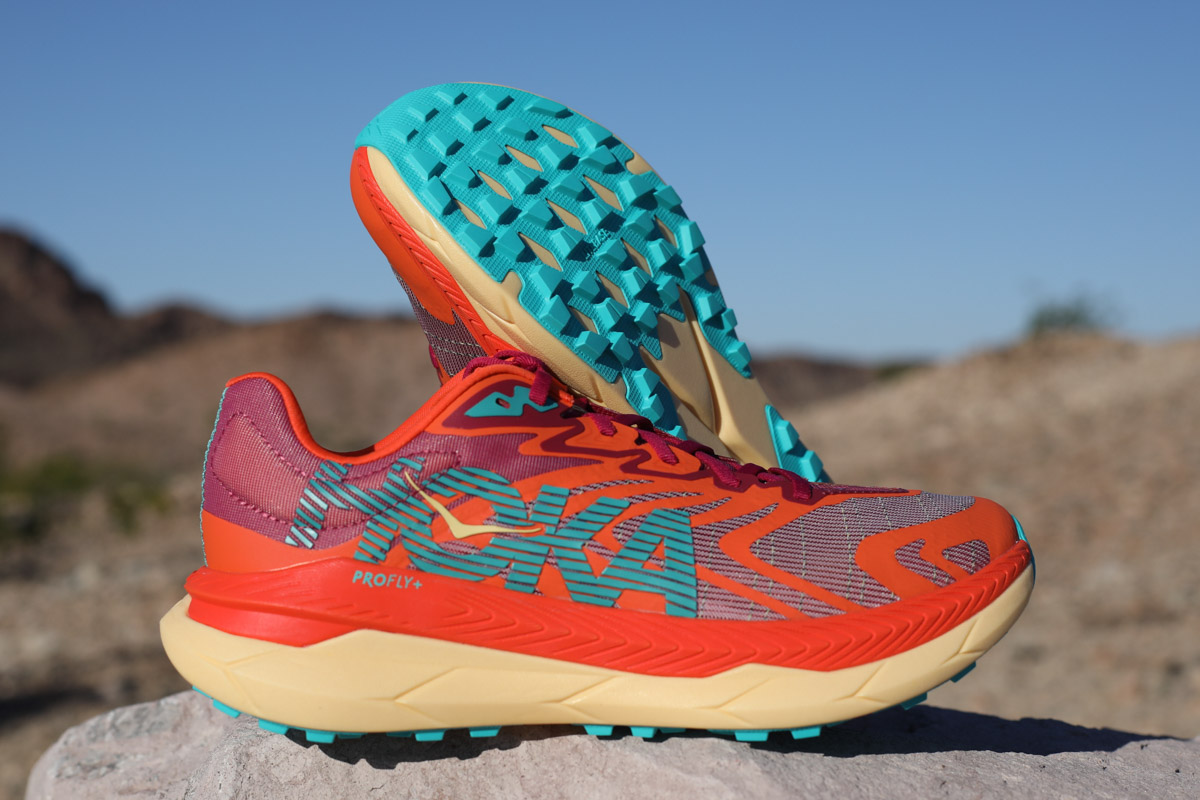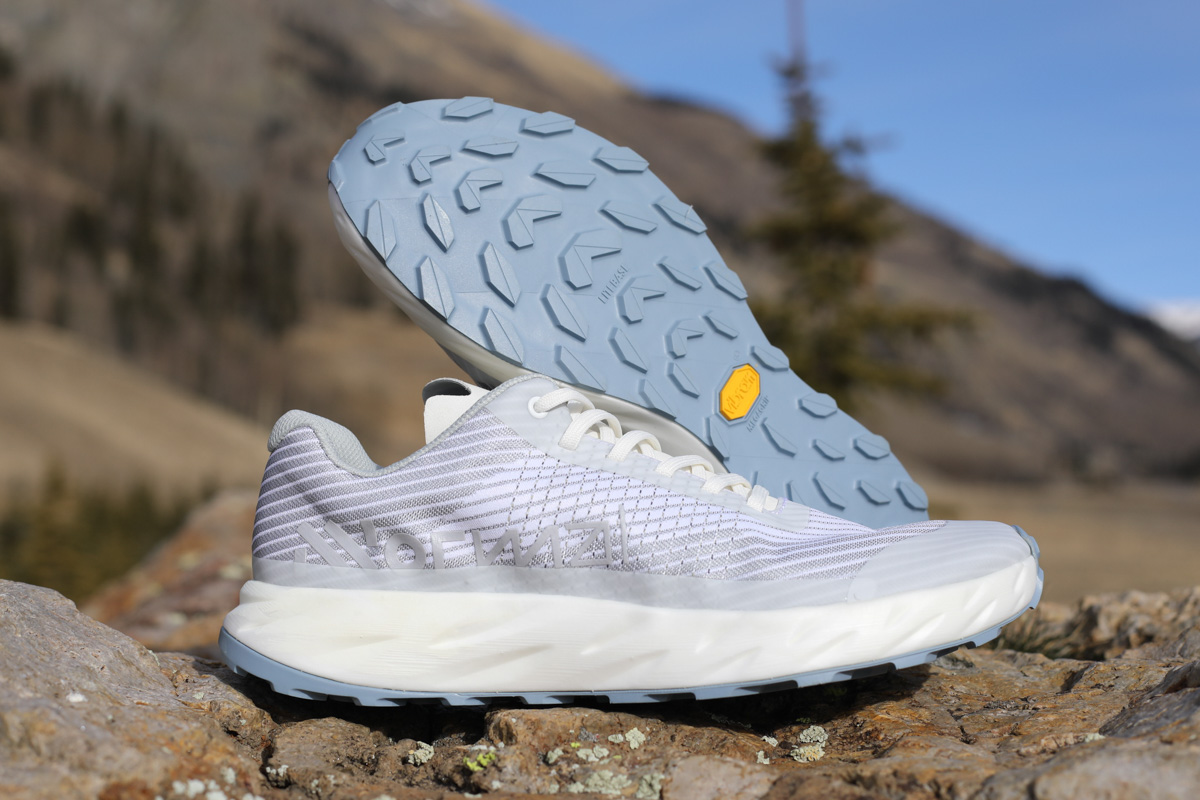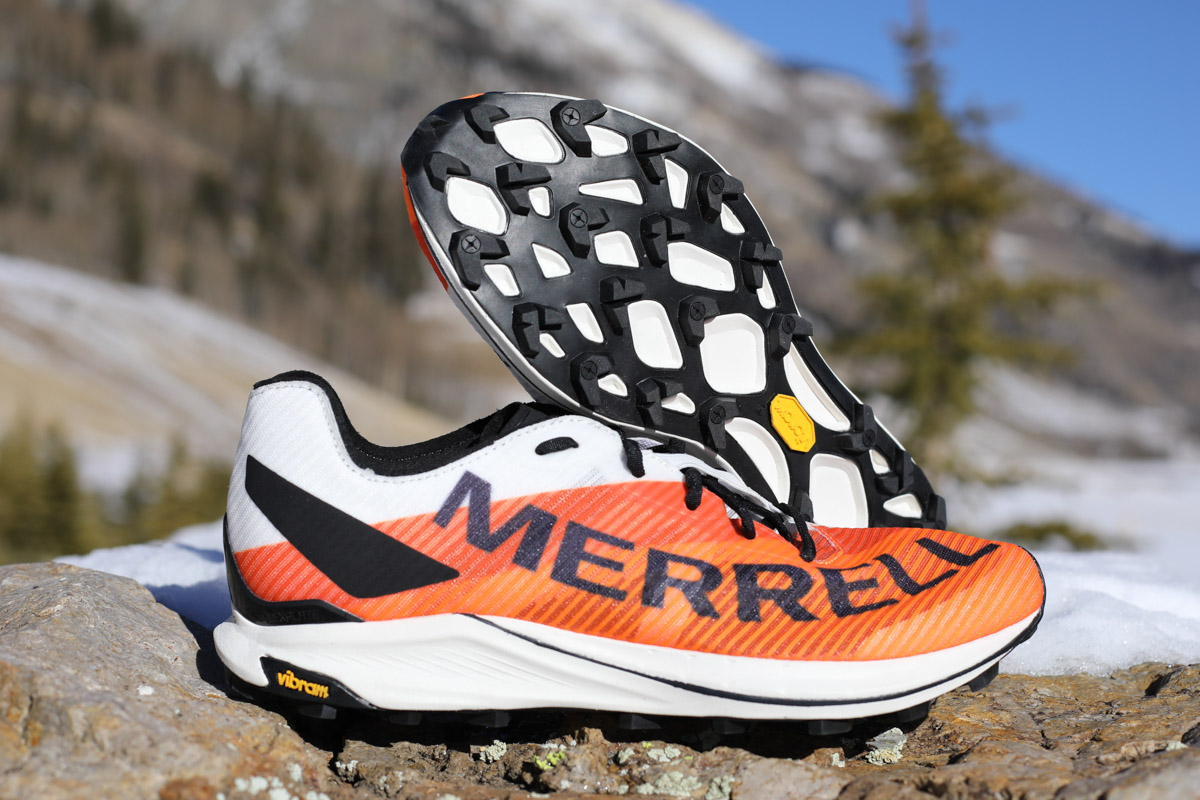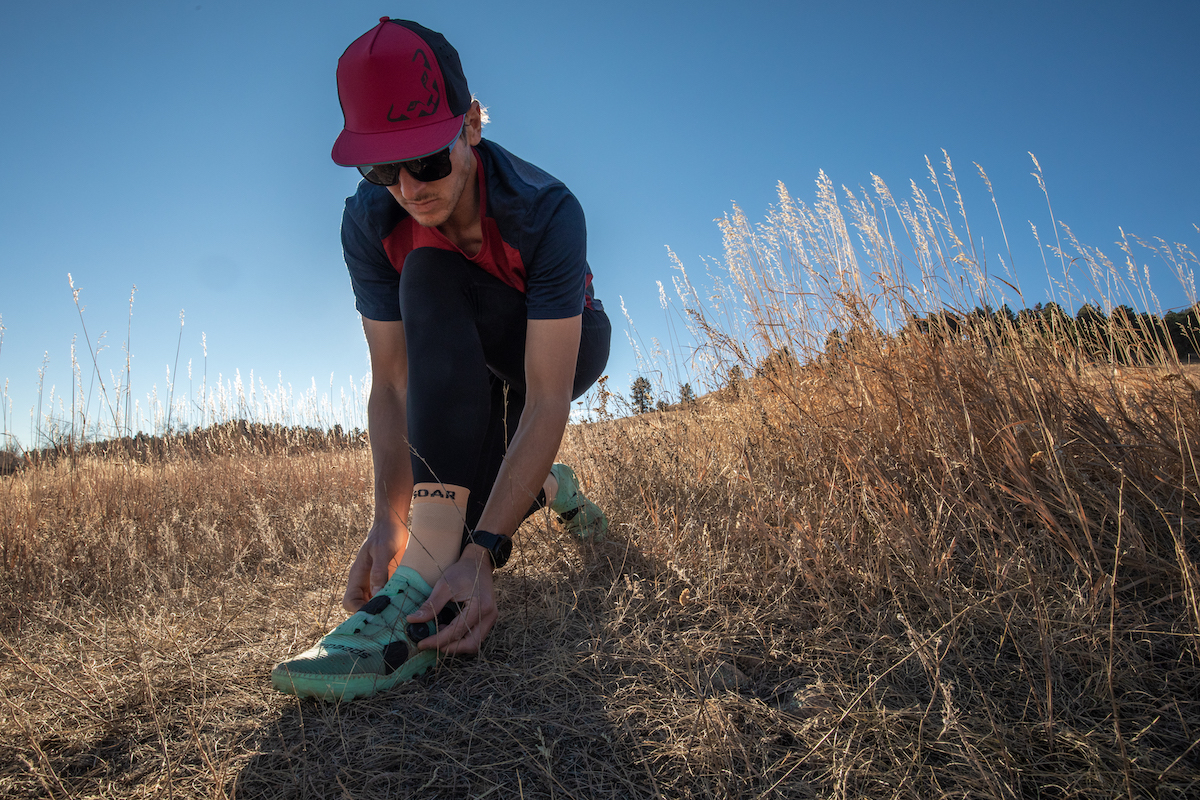When finding the best lightweight trail running shoes, you want one that strikes a balance between being nimble, durable, and cushioned enough to be comfortable but light enough to let you fly. This guide shares the best lightweight trail shoes that weigh nine ounces or less. Because the shoes here are very light, generally narrow, and with low-volume midsoles, many – but not all(!) – are not well suited for ultramarathon distances but are perfect for zooming up, down, and across everything from buttery singletrack to buttressed mountains.
We tested the shoes across various conditions and distances to determine which were best when speed was of the essence.
You can also learn more about finding the right lightweight trail shoes by jumping to our how-to-choose section.
Check out our best trail running shoes guide for more generalist trail shoes.
Best Lightweight Trail Running Shoes
- Best Overall Lightweight Trail Running Shoe: Salomon S/Lab Pulsar 2
- Best Lightweight Trail Running Shoe for Short Distances: Arc’teryx Norvan SL 3
- Best Lightweight Trail Running Shoe for Smooth Singletrack: Hoka Zinal 2
- Most Comfortable Lightweight Trail Running Shoe: Hoka Tecton X 2
- Best Lightweight Trail Running Shoe for Up to 50k Distances: Nnormal Kjerag
- Best Lightweight Trail Running Shoe for Technical Terrain: Merrell MTL Skyfire 2
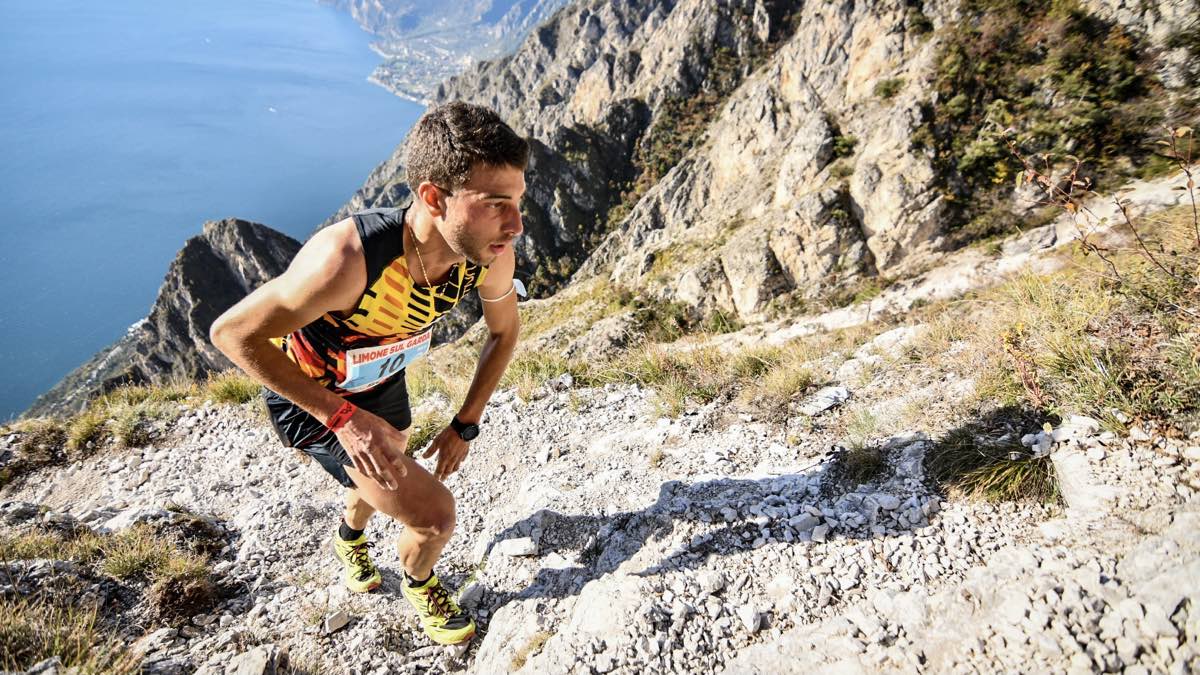
Lightweight shoes can make a big difference in short and steep races. Photo: Skyrunning/Maurizio Torri
Best Overall Lightweight Trail Running Shoe: Salomon S/Lab Pulsar 2 ($180)
Actual Weight (U.S. men’s 9): 6.2 ounces (175 grams) | Stack Height: 24.5/18.5 millimeters heel/toe | Drop: 6 millimeters
Pros:
- Incredibly precise fit
- Super-light
- Plush cushioning
Cons:
- Traction on dusty trail surfaces is weak
As professional hiker Andrew Skurka likes to say, “There’s light, and then there’s stupid light,” and the Salomon S/Lab Pulsar 2 is just a couple of grams away from stupid light. At an actual weight of just over six ounces, it floats in your hands out of the box and, except for the snugness, is virtually unnoticeable on your feet.
Our testers loved the original Salomon S/Lab Pulsar, and you can read the full review of that shoe, but they had a few areas where they thought the shoe could be better. Firstly, the upper of the original shoe was so tight that getting it on and off took a significant effort. Secondly, they wanted a better balance between the plushness of the midsole foam and ankle support, especially on descents. Salomon addresses both of these issues with this new version of the shoe.
With the new updates, the shoe maintains its same weight but is now buttery smooth and pliable when put on and is much more competent at speed. The upper uses the same breathable and light material and risks the same medial and lateral wear as the previous version, especially on abrasive trails. The shoe keeps its original 6-millimeter drop but feels stable and less dynamic than the previous version, which is a good thing on technical and fast descents. With shallow lugs, there is enough traction to keep the rubber side down in tacky conditions, but the shoe will completely sink in mud or slide out on dry and dusty trails. But with incredible forward propulsion and a truly illogical-feeling weight, this version elevates the original concept of this lightweight shoe to a new level.
The shoe has Salomon’s lightest ever midsole and a propulsive ride, the rocker style almost forcing you onto your toes even at a standstill. The Energy Foam midsole feels plush, which you can’t say about many other Salomon trail shoes. The Matryx Mesh upper is soft and strong and did not show signs of wearing through or pilling during testing. The Quicklace lacing system makes it easy to tighten down the uppers.
The only downside I find to this shoe is related to my local trail conditions: this shoe doesn’t have the best grip on dry and dusty trails. I suspect traction is much improved on slightly damp or loamy surfaces. The lugs are only 2.5 millimeters deep and are made of Salomon’s All Terrain Contagrip technology.
Read our full Salomon S/Lab Pulsar 2 review, and, for the latest update, our Salomon S/Lab Pulsar 3 review.
Shop the Salomon S/Lab PulsarBest Lightweight Trail Running Shoe for Short Distances: Arc’teryx Norvan SL 3 ($160)
Actual Weight (U.S. men’s 9): 6.4 ounces (181 grams) | Stack Height: 19/12 millimeters heel/toe | Drop: 7 millimeters
Pros:
- Durable upper
Cons:
- Unforgiving midsole
The newly updated Arc’teryx Norvan SL 3 keeps many of the features that led to us calling its predecessor, the Arc’teryx’s Norvan SL 2, the best lightweight trail running shoe of 2021 and addresses several of the issues the previous model had.
The main update is in the ankle collar. Whereas the older model allowed in too much debris and lacked ankle stability, the new ankle collar adds almost three-quarters of an inch more wrap-around protection, and overall, the stability is vastly improved. Virtually unchanged otherwise, the new upper replaces the SL 2’s gusseted tongue with a single-sock construction using the abrasion-resistant Matryx Micro material.
Where the SL 2 could be nearly folded in half, likely to make it more packable for multisport use in the mountains, the SL 3 has a much more traditional running structure and silhouette. That is not to say the multisport DNA is completely removed; a small loop inside the ankle ensures you can still attach a carabiner to the shoes to lash to your rock climbing harness or pack.
Some may find the shoe capable of all-day running, but our tester, at 180 pounds, finds the midsole foam and general firmness too unforgiving. Like a specialized tool, this shoe performs exquisitely on highly technical and abrasive trails, as the Matryx upper is genuinely resistant to abuse. You can take it to the mountains, with all its talus and other upper-preying impediments, and be sure you’ll return with an intact shoe. Finally, Arc’teryx, with its luxury brand pricing, actually has the second most affordable shoe in this guide.
Shop the Arc'teryx Norvan SL 3Best for Lightweight Trail Running Shoe for Smooth Singletrack: Hoka Zinal 2 ($160)
Reported Weight (U.S. men’s 10): 7.4 ounces (211 grams) | Stack Height: 30/25 millimeters heel/toe for U.S. men’s 10, 29/24 for U.S. women’s 8 | Drop: 5 millimeters
Pros:
- Fun for faster, less technical running
Cons:
- Longer or rockier runs can beat up your feet
The Hoka Zinal 2 is “a blast for light and fast running on rolling and moderately technical trails,” according to tester Alli Hartz. Hoka’s addition of a millimeter of lug depth and Vibram Traction Lugs makes the Zinal 2 much more trail-worthy than its predecessor, even if it remains best suited for smooth singletrack.
Hoka did remove a couple of millimeters of the midsole and changed up the shoe’s midsole material, making for better ground feel and a more responsive ride, but, with no rock plate, guiding use of this shoe toward less rocky singletrack and limiting its use to racing 50k or shorter for most runners. Put another way, if you want a fast ride for a couple of hours of less-technical trail running, then the Zinal 2 might be exactly what you’re looking for.
The stretch-knit collar and sock-like tongue add to the Hoka Zinal 2’s foot-in-glove feel that works well for an average foot shape. However, it might not be accommodating for wider feet or higher insteps.
Check out our in-depth Hoka Zinal 2 review.
Shop the Men's Hoka Zinal 2Shop the Women's Hoka Zinal 2
Most Comfortable Lightweight Trail Running Shoe: Hoka Tecton X 2 ($225)
Actual Weight (U.S. men’s 9): 9.1 ounces (258 grams) | Stack Height: 33/28 millimeters heel/toe | Drop: 5 millimeters
Pros:
- One of the best uppers on any trail shoe in years
Cons:
- Fast, technical descents may feel more unpredictable than other shoes due to the carbon plates
The Hoka Tecton X 2 is the only carbon-plated shoe in this guide and the only one with enough cushion to really run far. The ProFlyX foam midsole and two independent carbon plates provide a plush yet poppy ride at a very reasonable weight. The price of this shoe may seem excessively high, but we feel that the performance justifies the price. The Matryx upper is highly supportive and provides better lockdown than the previous version of the shoe. The material is also quick-drying. Our testers who also ran in the last version of the shoe found the new one more confidence inspiring on descents. The stiffer upper and cushioning closer to the ground provide a higher level of control. You can read our full Hoka Tecton X review to learn more about the original version of this shoe.
Many shoes in this guide are only good for shorter distances. When the runs get longer, this shoe shines. The extra cushion saves your legs, resulting in us calling it the Best Maximal Trail shoe in our Best Cushioned Trail Shoes guide. The Vibram Megagrip Litebase outsole provides excellent traction in a variety of conditions.
Check out our full Hoka Tecton X 2 review.
Shop the Men's Hoka Tecton X 2Shop the Women's Hoka Tecton X 2
Best Lightweight Trail Running Shoe for Up to 50k Distances: Nnormal Kjerag ($195)
Actual Weight (U.S. men’s 9): 7.8 ounces (220 grams) | Stack Height: 23.5/17.5 millimeters heel/toe | Drop: 6 millimeters
Pros:
- Increased durability and environmentally conscious construction
Cons:
- Limited availability
The Nnormal Kjerag was initially a hard shoe to acquire, but it was worth the wait!
For a debut shoe from a brand-new company, Nnormal delivered something that harkens back to its founder’s Salomon days while directionally veering into new paths with a much more accommodating upper and more forgiving foam in its EExpure midsole. While it’s not a highly cushioned shoe, the foam is so comfortable and forgiving that it’s easy to run for a long time in these shoes. The shoe doesn’t have an insole, but the foam helps keep your foot in place, resulting in less blister-causing slipping and rubbing.
The shoe doesn’t “take off” the way the Salomon S/Lab Pulsar 2 or Merrell MTL Skyfire 2 does, but it’s also a more well-rounded shoe for longer distances than other options in this guide.
Durability is possibly the key highlight of these shoes, with Kilian Jornet famously running in a single pair for an entire racing season in 2022 in everything from 100-mile races to runs less than 20 miles. An environmental ethos blends into every aspect of the shoe. Better durability means a longer life cycle, materials made in Europe mean fewer transport emissions, and several strategies for recycling Nnormal shoes, and even other brands’ shoes, mean you’re not just paying for an exceptionally lightweight race shoe but also placing a vote for environmental sustainability in running.
Shop the Nnormal KjeragBest Lightweight Trail Running Shoe for Technical Terrain: Merrell MTL Skyfire 2 ($200)
Actual Weight (U.S. men’s 9): 7.0 ounces (200 grams) | Stack Height: 25/19 millimeters heel/toe | Drop: 6 millimeters
Pros:
- Lightweight but durable materials
Cons:
- Minimalist design can be hard on the feet
Merrell has come out swinging in the fast and light trail racing world with its support of the Skyrunner World Series and the Merrell MTL Skyfire 2 launch. Out of the box, this shoe is an interesting combination of being super lightweight while still being made with traditionally robust materials, including a Vibram MegaGrip outsole with five-millimeter lugs. On uphill ascents, it feels like the shoes disappear from your feet. These are the shoes to set personal records on uphill time trials and vertical kilometers.
The innovative FlexPlate feels much more propulsive and, better yet, less noticeable than other plated trail shoes on the market. The plate sits between two layers of FloatPro Foam, which makes it comfortable, but the shoes’ six-millimeter drop and extremely minimalistic design meant that our shins were very sore the day after our first run in these shoes after having bombed down technical descents. This break-in period was brief, and our legs quickly adapted after that.
The uphill speed you’ll generate isn’t lost on the descents, as you’ll find exquisite foot placement and sure-footedness on many types of terrain. Despite its virtual translucence, the upper is quite supportive, and its mesh and TPU upper are very breathable. This shoe has a real “wow” factor you don’t find often.
Read our full Merrell MTL Skyfire 2 review.
Shop the Men's Merrell MTL Skyfire 2Shop the Women's Merrell MTL Skyfire 2
Comparing the Best Lightweight Trail Running Shoes
| SHOE | PRICE | WEIGHT | DROP |
| Salomon S/Lab Pulsar 2 | $180 | 6.2 ounces | 6 millimeters |
| Arc’teryx Norvan SL 3 | $160 | 6.4 ounces | 7 millimeters |
| Hoka Zinal 2 | $160 | 8.0 ounces | 5 millimeters |
| Hoka Tecton X 2 | $225 | 9.1 ounces | 5 millimeters |
| Nnormal Kjerag | $195 | 7.8 ounces | 6 millimeters |
| Merrell MTL Skyfire 2 | $200 | 7.0 ounces | 6 millimeters |
Why and How to Choose a Lightweight Trail Racing Shoe
The shoes in this guide are best for shorter trail runs and races, such as vertical kilometer races, half marathons, marathons, 50-kilometer races, and most skyrunning-style races where speed is more important than comfort.
For some of these shoes, a relative lack of comfort and cushion limits them to particular course lengths and types of terrain. Know your shoe’s characteristics and the race course terrain, and choose accordingly. A shoe like the Arc’teryx Norvan SL 3 would provide quite a beating if worn for distances longer than a marathon.
Also, remember that these lightweight trail shoes aren’t just for races! For those of us whose daily run doesn’t often exceed 10 miles, you could log many or even most of your runs in these shoes. Even if you are not looking for the best trail racing shoes, consider the shoes in this guide perfect for daily training runs when you prefer faster-feeling shoes with a more streamlined design. For example, our testers found the Nnormal Kjerag and Hoka Tecton X 2 comfortable enough for day-to-day running.
If you’re looking for more information on trail running shoes that provide more comfort and are better suited to everyday running, check out our Best Trail Running Shoes guide, while our Best Cushioned Trail Running Shoes guide will put plenty of bounce in your step.
Weight
How low should you go when choosing the best lightweight trail running shoes for your feet? All the shoes in this guide are nine ounces or less, but their degrees of lightness vary greatly. If the average ultrarunning shoe is around 10 ounces, then the six-ounce Salomon S/Lab Pulsar 2 will feel like an entirely different shoe class.
While all the shoes in this guide are very light, they have different enough characteristics to make them feel significantly different. You might opt for a slightly heavier shoe because of preferences for the midsole or outsole, or you might opt for the very lightest option because that’s what’s important to you.
A weight limit is a good benchmark when selecting a lightweight trail racing shoe, but there are many more elements to consider, and we chose a good cross-section of shoes with multiple features besides being light.
Some of the shoes in this guide are almost 50% lighter than normal trail running shoes. Does that make the best lightweight trail shoes minimalist? Not at all. These lightweight trail running shoes are indeed light, but that’s where the minimalist comparisons end. These shoes are cushioned, grippy, durable, and robust. In fact, the Hoka Tecton X 2 is a fully maximal shoe at a minimal weight.
Comfort
Are any of these shoes actually comfortable? Unfortunately, many of this guide’s best lightweight trail running shoes will not win a “most comfortable” competition if you compare them to shoes made for going super long, whether in ultramarathons or all-day adventure runs.
Most of these shoes are narrow and wide-footed runners or those with bunions may question which is least uncomfortable rather than choosing something particularly enjoyable to wear. The shoes here aren’t minimalist in the vein of barefoot trail running shoes, and many are actually very neutral in gait, but all are generally narrow and tough on runners with wide feet and feet prone to swelling during a long run. This is more an issue regarding the upper and shape of these shoes rather than the midsole feel, the latter of which is fairly outstanding in all the shoes in this guide.
All that being said, the Hoka Tecton X 2 is a reasonably comfortable shoe, especially for a lightweight one.
Durability
While durability for short trail races and quick training isn’t as important as for, say, a 100-mile race, it is still something to consider. All the shoes tested proved nearly as durable as their heavier counterparts.
The real innovation here is that so many brands can merge cushy midsoles into such an overall lightweight shoe. To our delight, the shoes in this guide maintained the midsole ride as much as the heavier shoes we’ve tested.
In general, upper durability is not as important as the midsole and outsole when choosing the best lightweight trail running shoes, but it is still a factor. The uppers of these shoes are excellent, and we didn’t find any to wear excessively quickly. Still, because they are lightweight shoes, most of the uppers will wear out more quickly than your normal running shoes. The updated upper of the Salomon S/Lab Pulsar 2 is made of Matryx mesh and held up well on trails, and the Arc’teryx Norvan SL 3 seemed virtually indestructible on rough terrain.

Andreu Blanes wears lightweight shoes during the 2022 World Mountain Running Championships Up-and-Down race. Photo: iRunFar/Meghan Hicks
Outsole and Midsole Characteristics
The type of trail race you’re running or the terrain you train on will likely influence the type of outsole and midsole you want.
The outsole on the Hoka Tecton X 2 is fairly low profile, but the midsole stack height is too extreme to move with stability over technical terrain. The Arc’teryx Norvan SL 3 has the biggest and most spaced-out lug pattern and is excellent for descending on all terrain, but the very light EVA midsole may leave you hurting after a 1,000-foot descent.
The solution in choosing a shoe is to match outsole and midsole characteristics to the course you’re running. You’ll want to pay attention to the midsole density, midsole stack height, lug pattern, and type of outsole rubber compound.
Why You Should Trust Us
Don’t worry; despite creating this guide for the best lightweight trail running shoes that are more appropriate for sub-ultramarathon-distance racing, we haven’t changed our name to iRunShort! Even if we are named iRunFar, we have years of experience on trails and in races of every distance.
Many runners can and will push these shoes beyond a marathon or 50-kilometer distance, but we wanted to test shoes that would be most inviting for short and steep trail running and mountain running. This is like wearing a pair of road shoes versus spikes at a track workout — different tools for different running.
We zeroed in on lightweight shoes that are more well-rounded for all kinds of trail running, instead of some shoes made traditionally just for running in mud or fell running; we left these out mainly because they are a category unto themselves.
To create this guide, we researched hundreds of shoes in the trail running space, narrowed our potential shoes to those weighing nine ounces or less, and took a couple of dozen shoes into the field. We tested these shoes across the U.S.’s mountain west, primarily in Boulder, Colorado, Moab, Utah, and Bend, Oregon.
Please note that product models are routinely discontinued in the running world, while new ones frequently come to market. At the same time, we here at iRunFar often keep using our top picks in our daily running… they’re our top picks, after all! Sometimes, that continued use results in uncovering product failures. With all this — product discontinuations, product introductions, and product failures — in mind, we routinely update our buyer’s guides based on past and ongoing testing and research by our authors and editorial team. While these updates can appear to be us pushing the newest product, it’s anything but that. Most products will likely remain the same when we update any buyer’s guide. That matches our goal: to get you in the best gear you’ll use for a long time.
Back to Our Top Lightweight Trail Running Shoes Picks

